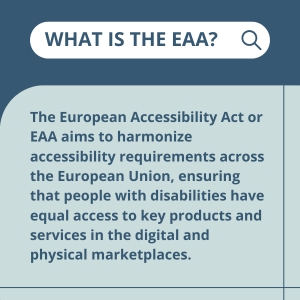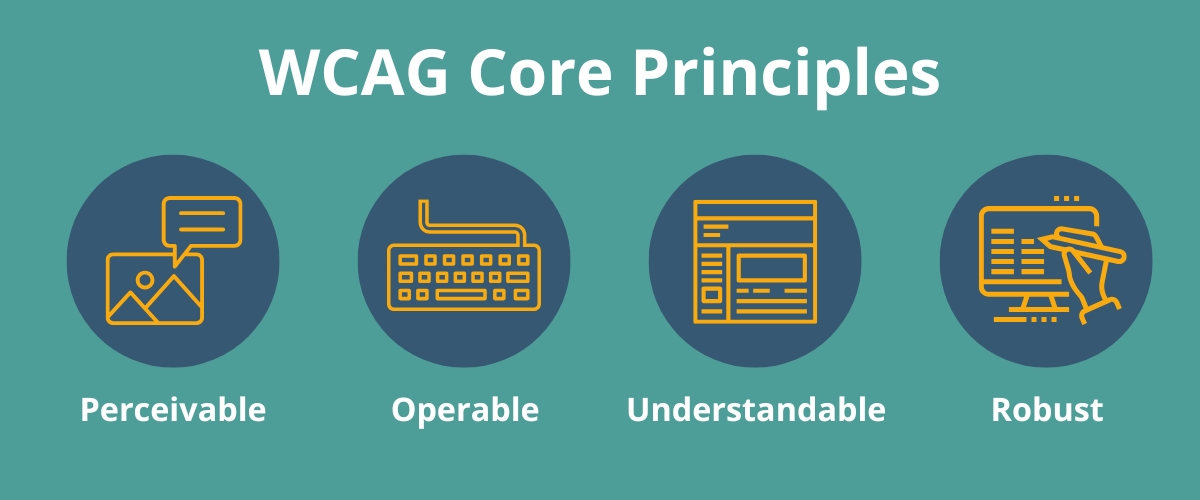As brands expand their reach globally, accessibility is becoming an essential factor in meeting diverse consumer needs, especially in regions like the European Union (EU), which has set requirements for digital and physical products. US brands aiming to succeed in the EU must be aware of the European Accessibility Act (EAA), which aligns accessibility standards across the EU and ensures products and services are usable by people with disabilities.
But what exactly is the EAA, and why is it important for US brands to pay attention?
What is the EAA?
In 2019, Directive (EU) 2019/882, commonly known as the European Accessibility Act or EAA, was created by the European Parliament and the Council of the European Union in response to EU member states having different accessibility laws. The EAA’s full enforcement starts June 28, 2025 and aims to harmonize accessibility requirements across the European Union, ensuring that people with disabilities have equal access to key products and services in the digital and physical marketplaces.
Companies offering any of the following to users will be affected:
- Websites and mobile apps
- E-commerce platforms
- Streaming services
- Banking and payment terminals
- E-books and e-readers
- Public transport ticketing and info systems
- Smartphones, computers, and ATMs
Do US brands need to follow the EAA?
US brands should prioritize EAA compliance, not only to meet the new regulations but also to align with existing ADA laws in the US. While the US doesn’t have explicit laws for web accessibility, the rising number of accessibility-related lawsuits underscores the growing importance of compliance. By adhering to WCAG standards, brands can enhance their offerings for the nearly 70 million adults with disabilities in the US, expanding their reach and fostering a more inclusive experience for all customers.
Keep in mind, there are also a variety of other ways to ensure website accessibility, such as addressing Google’s Core Web Vitals, following UX writing principles, following SEO best practices, and more. Have questions? Feel free to reach out to our team to discuss how we can help.
What will happen to my brand in the US if I’m not EAA compliant?
If a US brand doesn’t comply with the EAA while offering covered products or services in the EU, it can face serious legal, financial, and reputational consequences, even if it has no physical presence in Europe.
Embracing accessibility not only ensures legal compliance but also demonstrates a commitment to inclusivity, enhancing the overall user experience and broadening your customer base. Now is the time for US brands to take proactive steps toward accessibility, securing long-term success in a global marketplace.
What are the requirements of EAA compliance?
The EAA outlines a set of functional accessibility requirements that covered products and services must meet to ensure they are usable by people with disabilities. These are referred to as website content accessibility guidelines (WCAG). The requirements are not rigid technical specs but outcome-based, allowing flexibility in how companies achieve them, as long as the user experience is accessible by following the WCAG 2.1 Level AA will fill these requirements.
Demystifying WCAG involves understanding its versions, levels, and rules.
Website content accessibility guidelines are complex! For example, there are multiple WCAG versions (1.0, 2.0, 2.1, 2.2), conformance levels (A, AA, AAA), and various legal requirements depending on your industry and location. Evaluating accessibility also means understanding how to measure your site against dozens of WCAG success criteria—each with its own technical expectations.
If you’re unsure where to begin, check out our guide to WCAG versions, conformance levels, and evaluation methods to get clarity and practical next steps.
Where to begin with EAA/WCAG 2.1 compliance.
The best place to start with EAA or any accessibility project is with an accessibility audit. Our website accessibility experts help businesses take that first step with detailed WCAG accessibility audits. We identify usability barriers, provide actionable fixes, and tailor solutions to your goals so you can move toward full compliance with confidence.
Achieving web accessibility starts with focusing on the four core principles of WCAG: Perceivable, Operable, Understandable, and Robust. These principles form the foundation for making digital content accessible to all users. While the 13 WCAG guidelines provide specific criteria, it’s these core principles that are most important in ensuring your website meets accessibility standards. The Mad Fish team will review your website against these principles and the related guidelines to ensure a thorough and effective approach to accessibility.
WCAG Core Principles

- Perceivable: Content must be presented in ways users can perceive through sight, hearing, or touch.
Example: Are images using alt text? Are video captions available?
- Operable: Users should be able to navigate and interact with your site, regardless of their physical capabilities.
Example: Can all features be accessed using a keyboard alone?
- Understandable: The interface and content must be clear, consistent, and easy to follow.
Example: Is the language readable? Do users understand how to complete tasks?
- Robust: Your website must be compatible with a range of browsers, devices, and assistive technologies—now and in the future.
Example: Is the code properly structured to support screen readers and other tools?
By auditing your website, we help you determine which accessibility issues are critical to fix, which are recommended, and which may be non-essential based on your goals and compliance requirements.
Ensure Your Website Is WCAG Compliant and EAA-Ready
Accessibility isn’t just about compliance—it’s about creating a better experience for all users. Our digital marketing agency offers in-depth website accessibility audits to help you meet WCAG standards and prepare for regulations like the European Accessibility Act. Whether you’re looking to improve usability, increase your brand’s reach, boost search performance, or meet legal requirements, we provide tailored solutions that align with your brand and business goals.
Ready to make your website more inclusive? Get in touch with our team today.
 About the Author
About the Author
Nicole Niederhofer is the Creative Director at Mad Fish Digital in Portland, Oregon. With 14+ years of agency and in-house experience, she leads a team of designers, content strategists, and freelancers to bring creative strategies to life.

